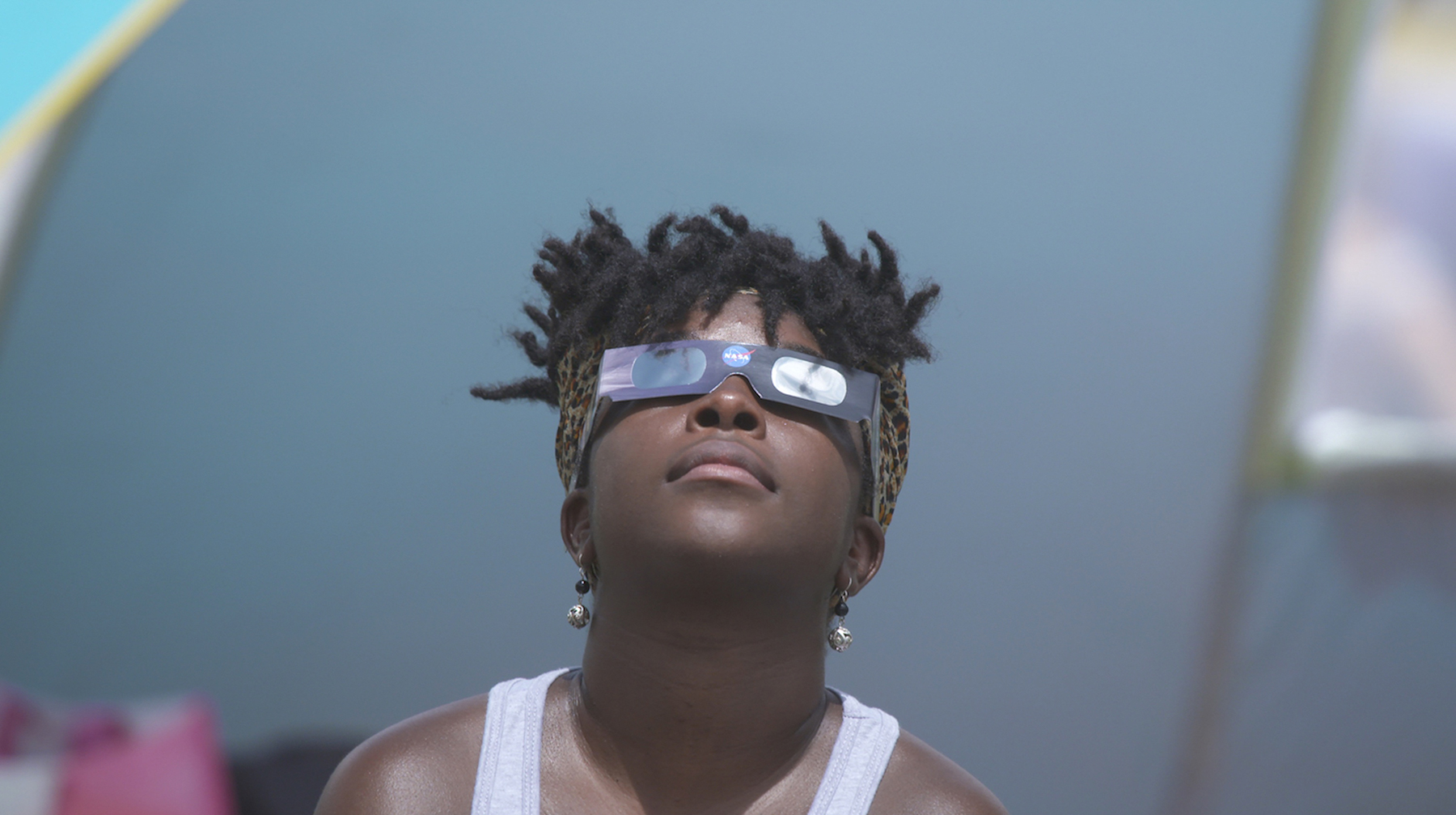
Theo Anthony, All Light, Everywhere, 2021. Film still. 109 min. © Future Image Solutions, LLC. Courtesy of Super LTD.
We touch the sun and the stars . . . we are everywhere at once, and . . . even our power to imagine ourselves elsewhere. . . or freely to envision real beings, wherever they are, borrows from vision and employs means we owe to it.—Maurice Merleau-Ponty, Eye and Mind, 1964
Our best machines are made of sunshine; they are all light and clean because they are nothing but signals, electromagnetic waves, a section of a spectrum, and these machines are eminently portable, mobile—a matter of immense human pain in Detroit and Singapore. —Donna Haraway, A Cyborg Manifesto, 1985
The sun is our factory. —Hito Steyerl, Factory of the Sun, 2015
I.
Flashes begin. A digital camera captures bodies in ecstatic motion at a wedding party in the south of France. The DJ is Oscar Lumière, a descendent of light who builds unidentified flying objects of sound and percussive pulse. I take a break from the dance floor to lie outside by the pool, looking up to the stars and listening to the birds in the darkness. Eventually, my eyes adjust and I realize that the celestial curtain above me is far brighter and denser than any I have seen before, like a big tent pitched from the peaks of the mountains. I see a shooting star, then three.
Not far from here are some of the earliest known paintings on earth. In present-day Spain and France, early humans and our predecessors painted onto the walls and ceilings of remote caves illuminated only by the flickering light of fire. Light and movement were primary elements in this first glow of animated art, which German filmmaker Werner Herzog calls a “proto-cinema”1 and Italian philosopher Mauro Carbone describes as a “sophisticated collective effort to contemplate moving images.”2 In caves and in cinemas, we gather in darkness, making sense of the world around us and the possibilities and limits of our perception. It is now believed that prehistoric cave art contains accurate representations of constellations visible at the time of their creation.3 If cave paintings were the first cinema, then perhaps images of stars exposed in the eyes of early humans were the earliest photography.
Theo Anthony’s All Light, Everywhere (2021) is a documentary film in the tradition of cave paintings, with its sights set on celestial and corporeal bodies. It contemplates big questions: How does vision inform knowledge? What is here? What is out there? What does here look like from out there? All of Anthony’s recent films advance kaleidoscopic, strobing inquiries into perspective, space, and judgment. Rat Film (2016) uses “a unique blend of history, sci-fi , poetry, and portraiture” to examine the legacies of racial injustice in Baltimore, Maryland.4 The short film Subject to Review (2019) explores “questions of spectacle, justice, and imperfect human knowledge”5 via the instant replay system in professional tennis. Anthony’s films focus on streets, labs, sporting arenas, and skies as sites for contemplating vision, documentation, and the machines that we have empowered to make decisions for us.
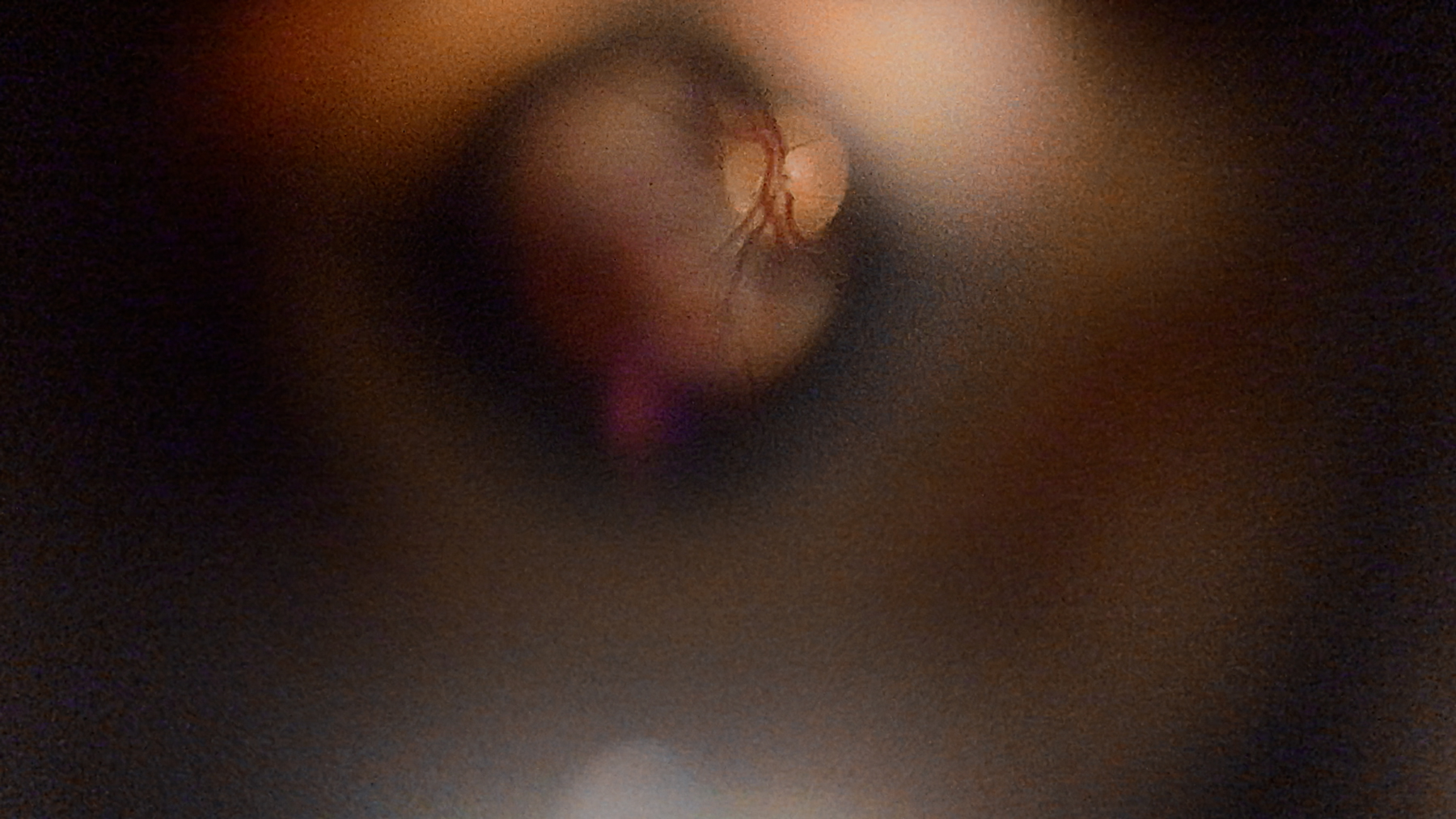
Theo Anthony, All Light, Everywhere, 2021. Film still. 109 min. © Future Image Solutions, LLC. Courtesy of Super LTD.
All Light, Everywhere begins in the eye of its director: a jerky, wide-angle shot of Anthony fixing a small camera and light into a device aimed at his eye and then a microscopic, illuminated view of the structures of his vision. Keaver Brenai’s voiceover narrates this opening, which focuses on a small fleck at the back of Anthony’s eye. Brenai’s cool voice explains that this fleck, the optic nerve, communicates light information from the eye to the brain and nervous system. At this wetware junction, where “the world meets the seeing of the world,” the eye receives no input. Here is the eye’s built-in blind spot around which vision is constructed.
This sequence introduces the blind spot as an abstract, metaphorical concept and also an anatomical, literal one. It is also an early hint that All Light, Everywhere is an essay film, a mode of cinema characterized by “blatant, self-searching authorial presence”6 as well as “heresy and openness.”7 In 2007, the filmmaker Jean-Pierre Gorin wrote that a black hole at the core of an essay film “prompts the existential necessity not to talk about it but to talk or film around it.”8 All Light, Everywhere reworks this convention by listening to the black hole at the center of the film, giving it a voice via voiceover narration. The film gazes at and also obliquely around its highly charged subjects: police body cameras, drones, and blind spots of state power. Along the way, it considers how we see, who does the seeing, and what remains unseen—and unknown.
II.
After exploring Anthony’s eye, Anthony and cinematographer Corey Hughes arrive at a stainless steel vault entrance with doors that open by retinal scan. This is the headquarters of Axon—formerly TASER International—where Tasers (guns that fire electrified darts that stun, immobilize, and kill people9 ) and Axon body cameras are manufactured. Axon’s “smart” electronic products—optical, ballistic, wirelessly connected, and worn by police—are a perfect nexus for Anthony’s cinematic interests.
At Axon, they meet marketing executive Steve Tuttle, whose declarations are crisp and self-assured. “Aim Far” and “Expect Candor” are core values at Axon. From the website: “Deliver with respect. Assume positive intent. Candor gets critical issues elevated and the truth on the table—it gets us to the right answer faster.”10 As with all for-profit corporations, and especially those that transact data and weaponry, the “right answer” is profit; the truth is in the fixed geometry of financial performance—a rising pyramid.
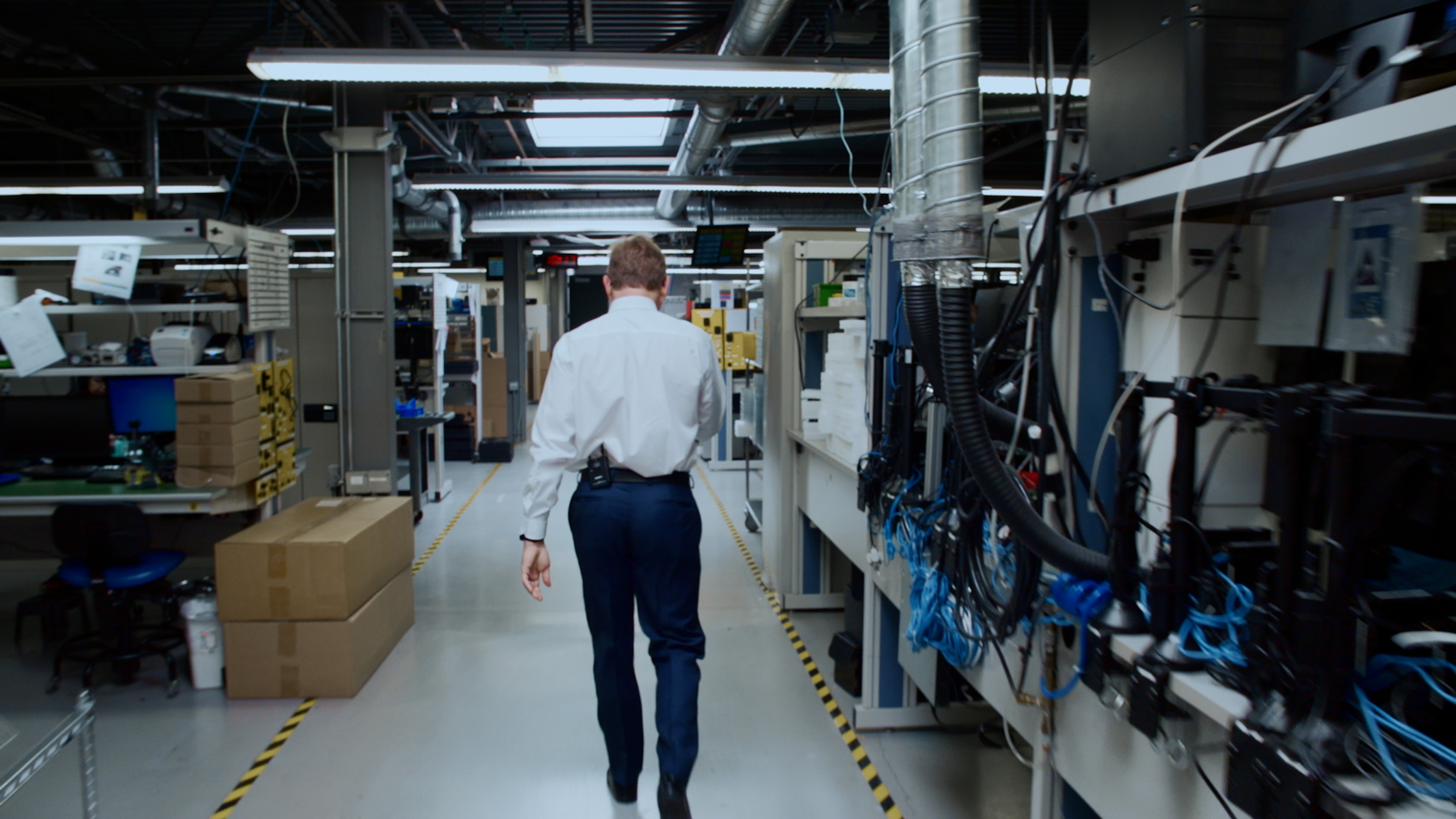
Theo Anthony, All Light, Everywhere, 2021. Film still. 109 min. © Future Image Solutions, LLC. Courtesy of Super LTD.
Tuttle ascends a staircase, waxing about committed collaboration on open floor plans and then about the need for black box spaces where research is done out of sight. Hughes’s steady camera focuses tightly on Tuttle’s behind. Later, Tuttle shows how a wall of glass can flash from transparent to opaque for sensitive presentations, and the camera lingers on Tuttle instead of turning to capture what he is demonstrating. Attending to Tuttle’s childlike enthusiasm trades the product for the production, allowing us to consider how tools are revealed and concealed. The window is a reminder of how corporate interests manipulate mirrored surfaces and the representations we see in them.
Cinematically, these scenes resist appearing neutral. Like a Live Photo on an iPhone, the camera captures awkward angles and affected set-ups, putting spotlights on the fabrications that editing can render invisible. In another sequence, Anthony and Hughes record a Baltimore City Police Department training session where officers first learn how to use their Axon body cameras. Similarly to the scenes at Axon, the film’s cameras stay rolling and observe private moments that go against the gloss of PR content, as when an officer rolls her eyes at the prepared remarks of the instructor and another officer texts under the table during a training, eyes straying from the PowerPoint.
We learn from Tuttle that Axon’s police body cameras are designed to approximate human perception; they do not employ night vision or infrared and leave plenty unseen. Laws empower officers to review body footage before giving sworn testimony, which creates an opportunity to use the camera’s blind spots and biases to support fictions that can exculpate their misconduct. As Anthony, Hughes, and Tuttle move through the factory, workers look up and shift their behavior when they realize they are on camera. This confirms Axon’s suggestion that being on the “business end” of a camera or weapon changes behavior. But whose behavior are these tools intended to change?
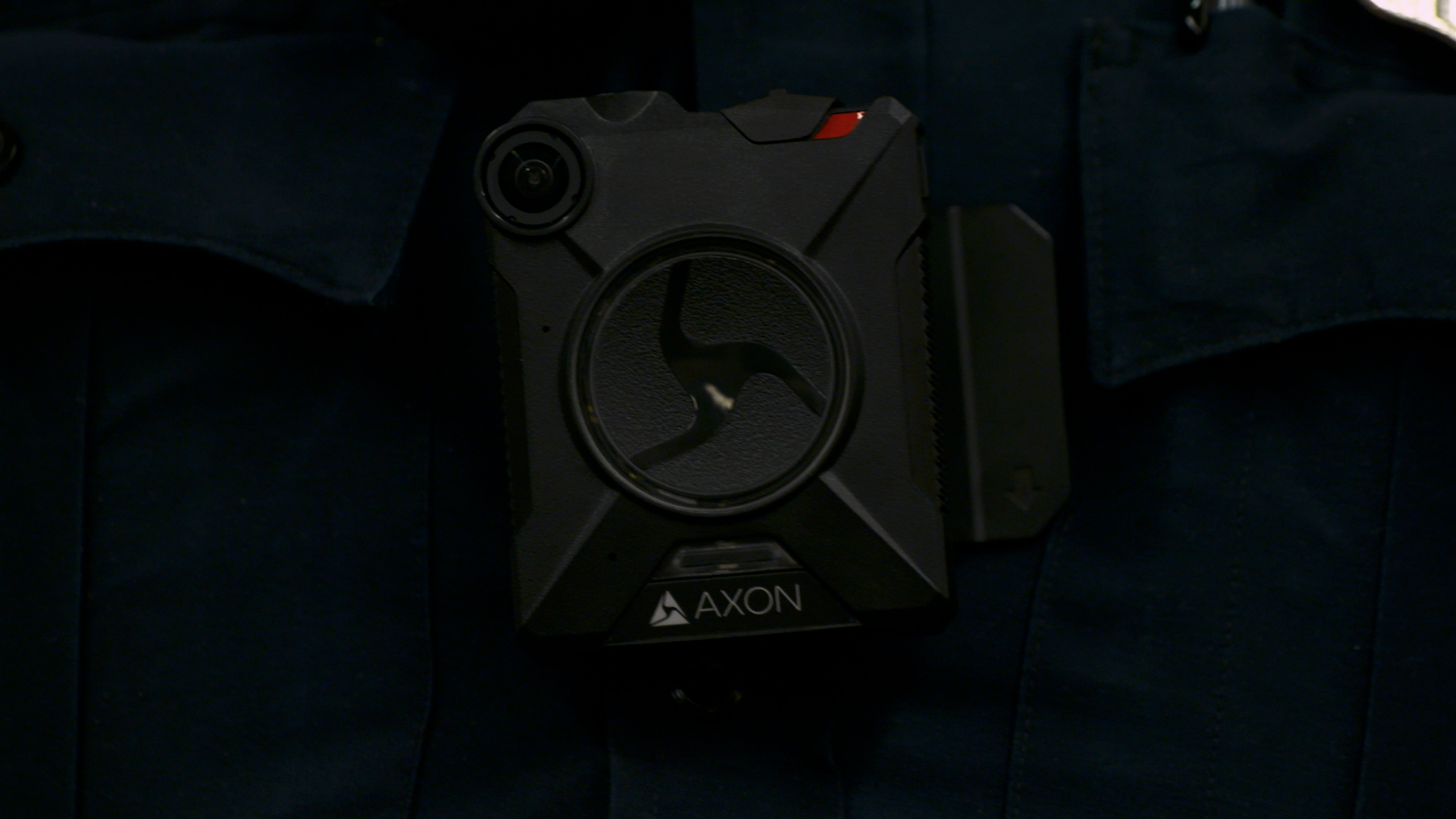
Theo Anthony, All Light, Everywhere, 2021. Film still. 109 min. © Future Image Solutions, LLC. Courtesy of Super LTD.
The week of my second viewing of All Light, Everywhere, a white 26-year veteran of the police force in a suburb of Minneapolis was wearing her body camera when she shot and killed an unarmed 20-year-old Black man named Daunte Wright. She later claimed that she had intended to draw her Taser. Who dies and who is held accountable when we assume positive intent with the police officers who wield Axon’s products?
In a later scene, Anthony wears one of Axon’s cameras in a suburban shopping mall. We see the serial code number for the evidence.com file (Axon’s trademarked cloud storage platform) in addition to digital advertisements in the mall, but we do not see Anthony. The body of the wearer is in the blind spot of the body camera. In generating “evidence,” the camera captures what happens to a police officer rather than what the officer does, with the “seer in shadow” and the “seen in the light.”11 As in a fragment from Goethe, we are “destined to see what is illuminated, not the light.”12 In a racist country with a highly militarized police force, this obfuscation benefits the powerful and those who choose to see criminals on one side of the camera but not the other.
III.
In 1935, Erwin Schrödinger devised a thought experiment to ponder knowledge and indeterminacy. He imagined a cat and a radioactive poison in a box. According to the quantum physics property known as superposition, the cat—who was equally likely to die inside the box or not die inside the box—was both alive and dead until the box was opened. Schrödinger’s box is often cited in relation to the observer effect, which states that the act of observation disturbs the observed system. The German filmmaker and writer Hito Steyerl, who is an innovator of the documentary essay film and a leading voice in conversations about new media, technology, and images, has written: “The role of the observer in actively shaping reality is one of the main achievements of quantum theory.”13
While observation limits quantum possibilities, the uncertainty principle states that observation cannot precisely measure pairs of variables (like position and momentum) at the same time. Steyerl uses this concept to problematize documentary filmmaking. In her essay “Documentary Uncertainty,” she describes the “uncertainty principle of modern documentarism,” wherein the “more immediate” documentary pictures become, “the less there is to see. The closer to reality we get, the less intelligible it becomes.”14
All Light, Everywhere lists Steyerl in its bibliography, but she is not directly referenced in the film. Instead, the film quotes the French criminologist Alphonse Bertillon: “The eye only sees in each thing that for which it looks, and it only looks for that thing of which it already has an idea.” In other words, human vision is always biased and subjective, and in Bertillon’s view, only scientific measurement and photography can provide an objective account. In All Light, Everywhere, we learn that, with cameras, Bertillon and Francis Galton brought eugenics-influenced forensic phrenology into police departments at the turn of the nineteenth century into the twentieth, thus inventing the image of a criminal: the mugshot. The film links these ideas and practices to histories of extraction and colonialism, as in Étienne-Jules Marey’s motion-study photography, which he shot in Senegal.
The film does not address the fact that Bertillon was a witness for the prosecution in the Dreyfus affair, where he fraudulently presented himself as a handwriting expert, assisting in the anti-Semitic conviction and subsequent imprisonment of an innocent man. Bertillon’s complex presence in the film led me to consider that photographers, filmmakers, and law enforcement officials all wield cameras and tell stories, attempting to capture in the light that which they would like to see. Getting close does not equal getting the truth. Images exclude what exists beyond their frame, and every film occludes and makes visible according to the intentions and biases of its team of makers. Viewing All Light, Everywhere is a meta experience of recognizing yourself as a seer who is asked to be vigilant in tracking the story from varied vantages.

Theo Anthony, All Light, Everywhere, 2021. Film still. 109 min. © Future Image Solutions, LLC. Courtesy of Super LTD.
In Schrödinger’s closed box, the cat is both alive and dead. It is something like a black box in physics, which is a system whose internal structure is not known. Some artificial intelligence networks are so complex that scientists use them without understanding how the processing happens inside the box. On the other hand, a black box in an airplane is readable, and the flight information that it stores can be reviewed when tragedy prompts us to look inside. Steyerl observes that the twentieth century “took the box and turned it inside out so it would spill all over the planet.”15 She adds, “The twentieth century also perfected observation as a method of killing. Measurement and identification became tools of murder. Phrenology. Statistics. Medical experimentation. Economies of death. In his lectures about biopolitics, Michel Foucault described the stochastic calculus that determined life or death. Counting and observation were radicalized to make sure that anything that entered the box died when the box was reopened.”16
IV.
In English, the word stochastic means “randomly determined; having a random probability distribution or pattern that may be analyzed statistically but may not be predicted precisely.”17 It is a technical adjective derived from the Greek stokhastikos, from stokhazesthai (to aim at, to guess), which comes from stokhos (aim). A pattern emerges, but randomness upsets our expectation of control. We aim. We guess. We shoot. We know. And we do not know. If the post-Enlightenment promise of statistics, data, machine learning, and other computational fields is to cast everything into the light of what is known, then stochastic indicates the limits to this ever-expanding frame, a word hanging out in a shadow.
The etymology of stochastic suggests a shoot-out in the field, laboratory, or studio. Aim the camera. Turn on the lights. Expose the image. Sequences of images congeal to tell a story about what is seen and who is looking, initiating a specular view. Ahead of his time, Henri Bergson was intrigued by the connections between human knowledge and the cinematograph, writing, “[Instead] of attaching ourselves to the inner becoming of things, we place ourselves outside them in order to recompose their becoming artificially. We take snapshots, as it were, of the passing reality.”18 He proposed that “the mechanism of our ordinary knowledge is of a cinematographical kind.”19 This observation anticipates our reliance on surveillance video and other moving image documents that mechanize synthetic knowledge.
One of the more ambiguous storylines in All Light, Everywhere features a group of subjects who sit in the offices of a neurological testing firm that is researching how the consumption of visual media affects the brain. Instruments are affixed to the subjects’ heads, and eye-trackers follow their gaze as they are presented with materials on a screen. Looking over their shoulders, we see that they are watching images from All Light, Everywhere, which creates a sort of cinematic ouroboros, a surveilled surveyor, or a film taking a selfie.
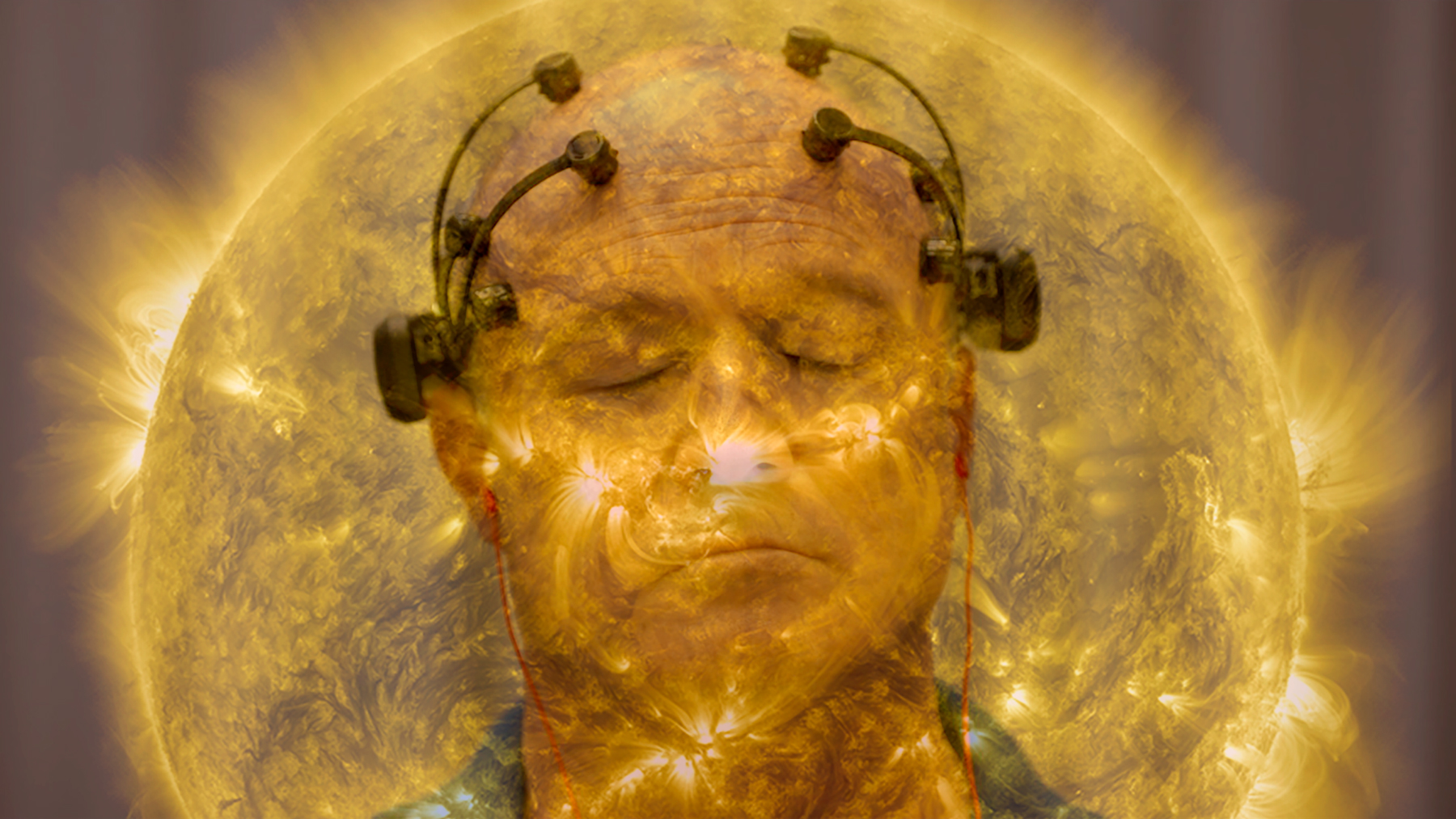
Theo Anthony, All Light, Everywhere, 2021. Press still. 109 min. © Future Image Solutions, LLC. Courtesy of Super LTD.
One subject is instructed to retain her focus on the screen while a plant begins to float in the periphery of her vision. The mise-en-scène is a peculiar and almost parodic science fictional element in an otherwise non-fictive film. With a floating plant, Anthony emphasizes how visual media can appear to bypass physical laws while also addressing how the camera does not passively document but rather actively changes what it sees and those who see what it sees. By simulating its own ingestion in the eyes of viewers, the film initiates a critical encounter that takes its audience not as depersonalized box-office metrics but as individual viewing subjects. How does watching this film change us?
The epilogue of All Light, Everywhere separates out and marginalizes Anthony’s work with high school video-production students in Baltimore. Silent intertitles tell us that this was originally intended to be a central narrative thread of the film, but as editing proceeded, the filmmakers could not reconcile the shots of young Black men experimenting with cameras alongside images of police weapons. After beginning the film with his optical vision and its limitations, Anthony ends the film by exposing the ethical conundrums of his imbricated editorial vision. As the film scholar Nora M. Alter explains, an essay film almost always offers “the appearance of its own self-criticism, threatening to silence the critic’s voice in advance.”20 Alter suggests that, when faced with this tactic, we must read between the lines and “expose a political im/perception—a level of signification in excess of what the filmmaker intended.”21
Looking back on Anthony’s self consciously enunciated inability to sensitively edit this scene of Black filmmakers into his film, I am reminded that earlier in the film, not far from scenes at Axon, a close-up holds the gaze of a young Black boy dancing alone near a gathering for the 2017 solar eclipse. As the music fades out, the camera stays with the boy until he looks away and smiles shyly, as if he is ready for the camera to move on. In images such as these, the white filmmaker, intentionally or not, acknowledges the importance of Black subjects’ agency and subjectivity, and also cannot help but instrumentalize this representation as a narrative seam.
In another scene, All Light, Everywhere documents debate at a Baltimore community meeting about a controversial surveillance drone program. Citizens speak out against the possibility of a drone flying over the neighborhood and relaying live imagery to the police; at the same time, two sets of video cameras record the meeting, and some citizens express discomfort with the excessive recording within the very room where such activities are being discussed. The drone operator, Ross McNutt, misleadingly asserts, “Cameras don’t take sides,” but of course they do. He even brought his own cameraman to offset Anthony’s team. Curiously, Hughes’s shots obscure the man behind McNutt’s camera, and we only see the camera, not its operator’s face.22
Some segments of All Light, Everywhere read like a science or history documentary, while others feel like hidden-camera television. Anthony and Hughes even attach the Axon camera to pigeons, again reconfiguring the subjectivity of the body camera wearer and placing the audience in “viewer” mode. Together, the images and sound—Brenai’s narration and a soaring original score by Baltimore-based musicians, including Dan Deacon and Susan Alcorn—explore interrelated ideas about place, subjectivity, and truth.
V.

Theo Anthony, All Light, Everywhere, 2021. Film still. 109 min. © Future Image Solutions, LLC. Courtesy of Super LTD.
Looking to the sun and the stars is a primary activity in science, art, magic, and myth-making. Constellations are useful because, like film, they are perceptual objects that construct our subjectivity and location in the act of looking. Too, celestial events like eclipses unite the esoteric, astrological, popular, and technological.
The Roman haruspex would draw a rectangular shape in the sky with his staff and make predictions based upon how many birds flew through the box and at what speed and direction.23 Everywhere—in cinema, on government forms, in Microsoft Excel—we look to boxes to tell us something. In the age of algorithmically generated recommendations and content, we must consider what and how data drives us. A desire to objectify, quantify, and tell the future has led to a proliferation of industries that squeeze information out of boxes. In extreme viral turbulence, stochasticity is a different kind of floating surprise, pointing toward what cannot be predicted using the variables at hand. It reminds us that light—and truth—flickers.
Waves waver and networked social platforms optimized for commercial luminescence sometimes go dark. Identity, object, image, light, and shadow all intermingle and superimpose when the device shoots, capturing the capturer and pointing toward an emergency exit door beyond which we cannot access until we push. Something is always just out of the frame. At the gatherings to observe the 2017 eclipse documented in All Light, Everywhere, a man balances his phone camera on a water bottle on the roof of a tent; elsewhere, thousands watch a live-feed of the sky in the pixels of LED walls. A darkened panel turns on and instantly harmonizes to the same signal that its neighbor panels display.
In the bluish brightness of handheld screens, we live luminously. We trade star charts, memes, selfies, and other “poor images.” (Per Steyerl, “A poor image is an image that remains unresolved—puzzling and inconclusive because of neglect or political denial, because of a lack of technology or funding, or because of hasty and incomplete recordings captured under risky circumstances.”)24 Pixelated, digitized bits zip around fiber-optic and airborne channels, fraying and degrading every time we open them.25 Evidence.com tracks each time Axon body camera files are viewed, opened, and downloaded, the access policed perhaps more than the officers who produce the images.
In All Light, Everywhere, an Axon representative attests that the next frontier for the industry will be artificial intelligence scanning footage and identifying crimes or other undesirable behavior. Just as photography was once considered objective, now data is thought of as an answer to subjective bias, as if it is not also manipulating and manipulatable. Representations of our presence and records of our movement online commingle with spit, sweat, and fingerprints, all of which are centrally stored and subject to hacking and abuse. Glitch, which has become a popular term in radical body and technology politics, may have originated from the Yiddish word glitsh, meaning a slippery place.26 Datum, person, subject: momentarily fixed within frames of surveillance yet still slippery.
All light and all shadow. The sun as the factory as the eye as the camera as the gun. We know our angles and adjust the lighting. Flooded, the flash is always firing. Art and life entangle in coproduction. Back at the wedding reception, a partygoer’s photographic flashes inspire a new move or extend a melodic loop. Amid the movement of music and dance, subjects are freed from total capture. There are glitches, photographs blur.
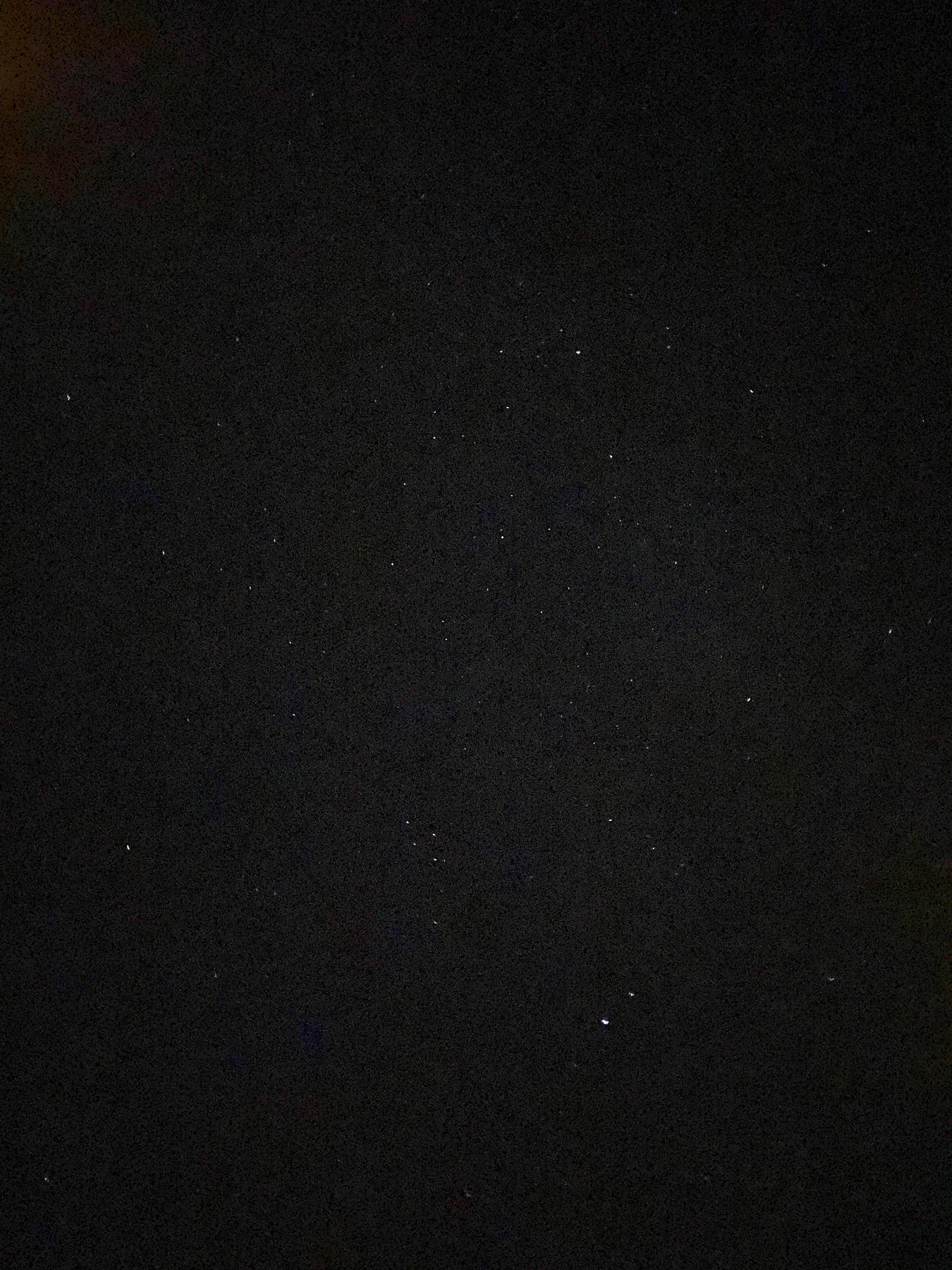
Photograph taken by the writer on his iPhone 11 of the night sky from Saint-Jean-de-Buèges, France on August 8, 2021.
Watching the night sky, I do not feel like a big positive subject gazing out into a yawning void. Rather, I feel presence above and beyond me hugging in mutual pressure, both the light in the sky and a faint green coming from inside. In English, the expression shooting star calls to mind guns and cameras, something that flashes quickly and then disappears. I recall that the French word for a shooting star is étoile filante (stringy star). As clean and sharp as All Light, Everywhere is, the film operates like a patchwork tapestry woven from strands that leave room for new projections. It inspires us to strive to keep track of many threads winding, interweaving, and unraveling, on-screen and off, in light and in shadow.
Max Levin is a writer, curator, and artist based in New York City.
